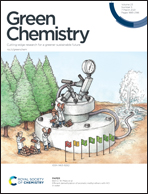CaCl2 molten salt hydrate-promoted conversion of carbohydrates to 5-hydroxymethylfurfural: an experimental and theoretical study†
Abstract
Alkaline earth metal salts are environmentally friendly and economical. They have attracted much attention in the process of biomass conversion, especially for isomerization and dehydration. However, the lack of understanding of the alkaline earth metal-mediated catalytic mechanism prevents the achievement of high HMF yields from glucose or fructose. Herein, we performed experimental and theoretical studies on CaCl2-catalyzed glucose-to-fructose isomerization and fructose-to-HMF dehydration. In CaCl2 solution, the highest fructose yield (33.6%) from glucose can be achieved at 80 °C. Meanwhile, the presence of CaCl2 in fructose-to-HMF dehydration notably improved fructose conversion. A “one-pot” isomerization–dehydration of glucose to prepare HMF was designed and 100% conversion and 52.1% HMF yield were obtained. The CaCl2 solution can be reused for five runs while maintaining catalytic activity without regeneration. Through 1H NMR, 13C NMR, DOSY-NMR and DFT calculations, we concluded that the coordination between the C1/C2 sites of the β-glucopyranose tautomer and CaCl2 promoted the 1,2-intramolecular hydride shift of glucose, thus rapidly converting glucose into fructose. Similarly, Ca2+ can complex with the C2/C6-OH of β-D-fructofuranose and stabilize this tautomer, which easily forms HMF. This is the main reason that CaCl2 can promote the preparation of HMF from fructose.



 Please wait while we load your content...
Please wait while we load your content...